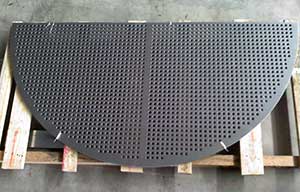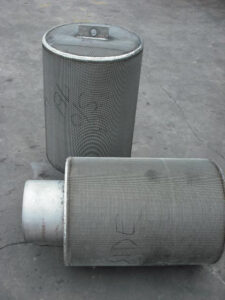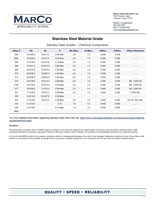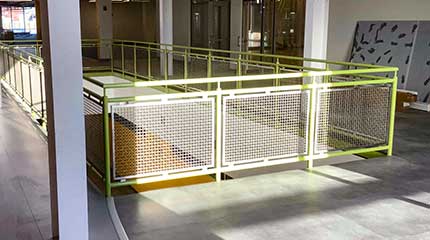
Stainless Steel Grades
Stainless steel grades are iron alloys that contain more than 10.5% of chromium. Other alloys are added to stainless steel to amplify its properties. The grading is based on the metallurgical structure and nature of stainless steel. The grades of stainless steel are categorized into different families on the basis of the properties that they display.
Our Stainless Steel (SS) Products
Marco Specialty Steel stocks a large amount of SS products including wire cloth, perforated metal, expanded metal, bar grating, safety grating, architectural products, and more.

Custom Stainless Steel Fabrication
Our fabrication shop routinely custom fabricates stainless steel products for all types of industries.
Austenitic Stainless Steel – Series 100-300
The family of austenitic stainless steel are alloys that contain 16% chromium and 6% nickel. Other elements such as copper, titanium or molybdenum can be added to amplify its properties. The combination of all these elements makes it suitable for use in work involving high corrosion resistance and high-temperature resistance. It is also effectively resistant to atmospheric corrosion and corrosion by organic, oxidizing and mineral acids. It displays properties like high ductility, cryogenic toughness, and weldability. This makes it possible to fabricate austenitic stainless steel by punching, spinning, welding, drilling, bending, etc. It is also non-magnetic. The important austenitic grades are the 200 series (chrome-manganese series) and the 300 series (chrome-nickel series). The 300 series is the largest manufactured stainless steel type in the world. Austenitic stainless steel is mainly used in the manufacture of cutlery, kitchen appliances and consumer durables and also for the construction purposes.

Ferritic Stainless Steel
The family of ferritic stainless steel alloys has a chromium content of more than 10.5% and a low carbon content. They are plain chromium grades, display magnetic properties and cannot be hardened. They are not suitable for fabrication and are moderately resistant to corrosion. They can be polished and are used for the manufacture of automotive exhausts and sometimes for welding applications.
Duplex Stainless Steel – 2304 and 2205
The family of duplex stainless steel alloys possesses a high chromium content of 18% to 28% and a moderate nickel content of 1% to 8%. They are a combination of austenitic and ferritic stainless steel alloy structures, and they may also contain molybdenum, copper, manganese or tungsten. They display high yield strength and resistance to stress corrosion, cracking, and ion attack. They are used in the paper and pulp, petrochemical, and marine application industries and in the desalination plants.

Martensitic Stainless Steel – Series 400
The family of martensitic stainless steel are alloys having 11.5% to18% chromium and high carbon content of 0.1% to 2%. It can be easily hardened by subjecting it to heat, and is highly resistant to abrasion, but it displays less resistance to corrosion compared to other alloys of stainless steel. It displays magnetic properties and is used in the manufacture of surgical instruments, valves, knife blades, etc.
Rust and Stainless Steel
To get the information you need, read our blog about metals that don’t rust.
304 vs 316 Stainless Steel
Find out the difference between 304 and 316 Stainless Steel in our blog.
Contact Marco For All Your SS Needs
Please contact us today to learn more about how we can provide a high quality stainless steel solution for your specific needs.
Stainless Steel Grades – Chemical Composition
| Alloy # | CR | Ni | C | Mn.Max. | Si-Max. | P.Max. | S.Max. | Other Elements |
|---|---|---|---|---|---|---|---|---|
| 304 | 18.0/20.0 | 8.0/11.0 | 0.08 Max. | 2.0 | 1.0 | 0.040 | 0.030 | .......... |
| 304L | 18.0/20.0 | 8.0/11.0 | 0.03 Max. | 2.0 | 1.0 | 0.040 | 0.030 | .......... |
| 305 | 17.0/19.0 | 10.0/13.0 | 0.12 Max. | 2.0 | 1.0 | 0.040 | 0.030 | .......... |
| 308 | 19.0/21.0 | 10.0/12.0 | 0.08 Max. | 2.0 | 1.0 | 0.040 | 0.030 | .......... |
| 309 | 22.0/24.0 | 12.0/15.0 | 0.20 Max. | 2.0 | 1.0 | 0.040 | 0.030 | .......... |
| 310 | 24.0/26.0 | 19.0/22.0 | 0.25 Max. | 2.0 | 1.0 | 0.040 | 0.030 | .......... |
| 314 | 23.0/26.0 | 19.0/22.0 | 0.25 Max. | 2.0 | 1.0 | 0.040 | 0.030 | .......... |
| 316 | 16.0/18.0 | 10.0/14.0 | 0.08 Max. | 2.0 | 1.0 | 0.040 | 0.030 | Mo. 2.00/3.00 |
| 316L | 16.0/18.0 | 10.0/14.0 | 0.03 Max. | 2.0 | 1.0 | 0.040 | 0.030 | Mo. 2.00/3.00 |
| 317 | 18.0/20.0 | 11.0/15.0 | 0.08 Max. | 2.0 | 1.0 | 0.040 | 0.030 | Mo. 3.00/4.00 |
| 321 | 17.0/19.0 | 9.0/12.0 | 0.08 Max. | 2.0 | 1.0 | 0.040 | 0.030 | Ti 5xC Min. |
| 330 | 14.0/16.0 | 35.0/37.0 | 0.25 Max. | .... | .... | .... | .... | .......... |
| 347 | 17.0/19.0 | 9.0/13.0 | 0.08 Max. | 2.0 | 1.0 | 0.040 | 0.030 | Cb+Ta 10xC Min. |
| 410 | 11.5/13.5 | .... | 0.15 | 1.0 | 1.0 | 0.040 | 0.030 | .......... |
| 430 | 14.0/18.0 | .... | 0.12 Max. | 1.0 | 1.0 | 0.040 | 0.030 | .......... |
| 904L |


 What is Stainless Steel?
What is Stainless Steel?